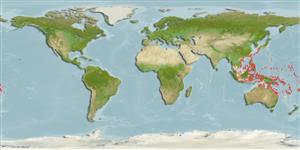Actinopterygii (ray-finned fishes) >
Perciformes (Perch-likes) >
Gobiidae (Gobies) > Gobiinae
Etymology: Gobiodon: Latin, gobius = gudgeon + Greek, odous = teeth (Ref. 45335). More on author: Bleeker.
Environment / Climate / Range
Ecology
Marine; reef-associated; depth range 3 - 20 m (Ref. 90102). Tropical, preferred ?
Western Pacific: Papua New Guinea.
Size / Weight / Age
Maturity: Lm ? range ? - ? cm
Max length : 6.6 cm TL male/unsexed; (Ref. 90102)
Short description
Morphology | Morphometrics
Dorsal
spines
(total): 6 - 7;
Dorsal
soft rays
(total): 8;
Anal
spines: 1;
Anal
soft rays: 8. Characterized by plain blackish color of adult; juvenile with white body and pair of black stripes; head and tail with dark spots; absence of scales; complete pelvic fin frenum and basal membrane; depth of body at level of pelvic fins 3.7 in SL (Ref. 90102).
A coral-commensal species (Ref. 72446). Solitary or in groups. Also found in sheltered lagoons and coastal reefs in 3-20 m (Ref 90102).
Life cycle and mating behavior
Maturity | Reproduction | Spawning | Eggs | Fecundity | Larvae
Kailola, P.J., 1991. The fishes of Papua New Guinea: a revised and annotated checklist. Vol. III. Gobiidae to Molidae. Research Bulletin No. 41, Research Section, Dept. of Fisheries and Marine Resources, Papua New Guinea. 153 p. (Ref. 6771)
IUCN Red List Status (Ref. 115185)
CITES (Ref. 94142)
Not Evaluated
Threat to humans
Harmless
Human uses
More information
Common namesSynonymsMetabolismPredatorsEcotoxicologyReproductionMaturitySpawningFecundityEggsEgg development
Age/SizeGrowthLength-weightLength-lengthLength-frequenciesMorphometricsMorphologyLarvaeLarval dynamicsRecruitmentAbundance
ReferencesAquacultureAquaculture profileStrainsGeneticsAllele frequenciesHeritabilityDiseasesProcessingMass conversion
Tools
Special reports
Download XML
Internet sources
